1 year ago
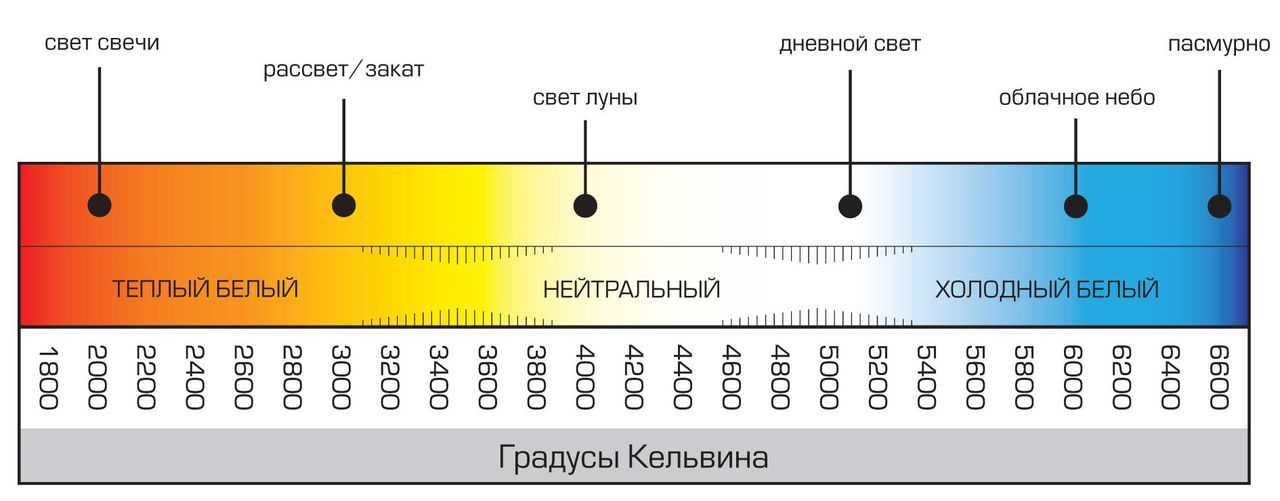
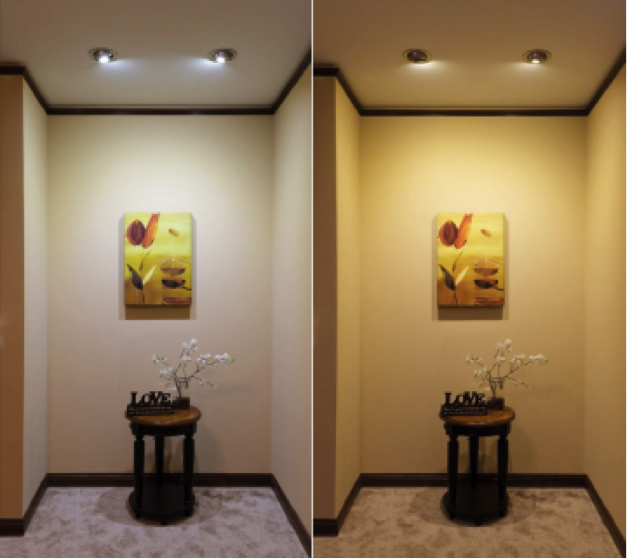
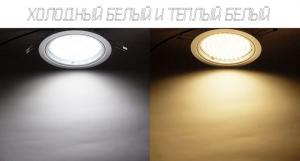
Every designer knows this rule well. If you are designing a project for an apartment or house, be sure to take into account as many factors as possible. As for lighting in the interior, it always plays a paramount role. After all, it is light that can breathe life into the designer's idea. It is he who emphasizes the most important details in interior design.
Not so long ago, only incandescent lamps could be seen in living quarters, which emitted the familiar yellow color. Illumination was taken to vary the direction of light and brightness. Now it's not like that.
Energy-saving lamps appeared, which opened up new opportunities for designers. They can now afford to add to everything the variation in the color of the glow of the lamps. And therefore, for example, when you cross the threshold of an electrical goods store, you cannot but see that the light from different light bulbs different colour. Well, what color do you prefer?
What types of lamps exist
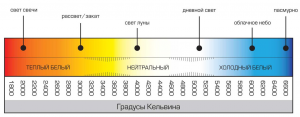
Modern light sources are usually divided according to the shape of the bulb, the principle of operation and efficiency. However, it is important for us now to determine what kind of light bulbs provide. And therefore, when buying light bulbs, you need to ask the seller for their color rendering index.
This is an important indicator. It depends on him whether the colors of the interior will look pleasant and adequate under artificial lighting.
The color rendering index is denoted by the letters Ra. In order for the room to have normal lighting, the index should be 80-90, and even better ideal - 90-100. In this case, the light can be cold or warm. And it does not depend on the index. And here you need to take into account the place and specifics of the use of lamps.
Glow color energy saving lamps characterized by the so-called color temperature. Kelvin (K) is a unit of measure for color temperature. The lower the value of the parameter, the closer the glow color is to red. The higher it is, the closer it is to blue.
Currently, experts distinguish three primary colors. Warm white light - 2700 K. Natural white light - 4200 K. Cool white light - 6000 K or 6400 K.
What is the difference between cold and warm light
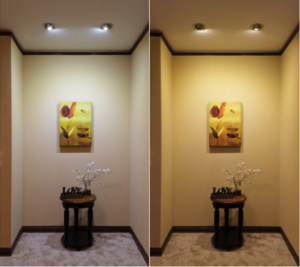
Experience shows that a person considers cold white light to be the most attractive. Probably because it gives more illumination.
Cold light is able to set a person in a business mood. It stimulates physical and mental work, does not allow you to relax. This light is recommended in an office space or study. After all, here people are doing something for a long time. For bedrooms and children's rooms, this light is not suitable.
In terms of its spectrum, natural white light is closest to natural light. And therefore it is well suited for lighting a children's room and living room.
Warm white light with a yellowish tinge, reminiscent of incandescent light. It makes sense to use it for lighting where there is no need to create an increased working concentration. Where we relax after work, that is, in living rooms, bedrooms, dining rooms.
Light has the ability to drown out or emphasize any shades in the interior. These properties are found wide application at the designers. For example, it is well known that warm light can enhance the color of interior details that are painted in warm colors.
Warm is considered to be halogen lamps. However, they emit radiation that is closer to the natural light of the shade. That is why they hardly distort colors. Such lamps are recommended to be placed next to mirrors and in bathrooms. After all, they do the right transfer of skin color.
Remember that warm light dulls cold colors. This means that when the interior is illuminated with cold light, the elements of the interior that are painted in a warm spectrum will be somewhat dull. But the green and blue details will begin to play in all their glory.
Proper lighting is the key to your health and good mood! The quality of light affects not only vision, but also the human psyche. Remember sunlight. It was created by nature, provides good visual perception, gives us positive energy, and also has a positive effect on the basic life processes of the body.
Daylight hours cannot provide us with constant sunlight, so in its absence we all switch to artificial lighting. Lighting lamps are divided into four main types: incandescent, fluorescent, halogen and LED. Each variety is distributed by the amount of energy consumed, brightness and quality.
What is the quality of the light output
The quality of light is determined by all the properties of the source used. Warm or cold, bright or dull, the color of the shade, the distortion of the color of surrounding objects - all these are the properties of artificial lighting lamps.

Warm and cold light is perhaps the main parameter that you should pay attention to when choosing artificial lighting lamps. Light temperature is divided into 4 groups:
- Warm - comfortable;
- Warm - white;
- Cold white;
- Cold - daytime.
Each group is characterized by a color temperature, which is measured in Kelvin (K). Warm and cold light is determined by the corresponding color temperature. The higher the temperature, the greater the saturation with cold. Based on this, warm comfortable is achieved at 2500 K, and cold daylight at 6500 K. All the nuances of the warmth of light are determined by different light moods in the appropriate environment. And often interior design is very dependent on saturation luminous flux.
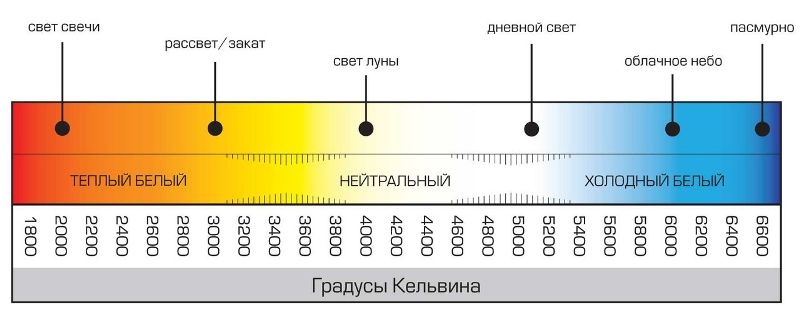
Warm comfortable - designed to create a cozy, relaxing atmosphere. In a room with warm, comfortable lighting, visual perception is at rest.
Warm white - mainly used as the main lighting of residential premises. According to the temperature scale, it has a mark of 2700 K, which does not significantly distinguish it from a warm comfortable one. Visual perception causes a feeling of peace, clarity and tranquility. Cool white is a neutral, optimal light for certain areas of a living space. This shade is necessary for concentration and accurate display colors surrounding flowers.
Cold daylight - invigorating, stimulating, as close as possible to clear natural light. In visual perception, it has a significant psychological emphasis, prompting working mood and concentration on the little things. This is the ideal color temperature for long-term work with texts and fine details. Cold daylight is the best way to protect the eyes from fatigue during prolonged hard work. Daytime artificial light is not dazzling or relaxing, it is neutral.
The role of the lamp in the interpretation of light
To create an optimal interior lighting system, lamps alone are not enough. Lighting will play a key role here. After all, the lamp is the main aesthetic addition to the light source in the interior.
The direction of the source, tone and distortion during interpretation depend on the shape and material of the lamp. Spotlights are designed to direct the rays of artificial lighting to certain interior items.
Ceiling lamps and chandeliers create light dispersion, thanks to transparent glass or crystal - light rays pass through the ceiling and are evenly distributed in space.
Wall lamps and night sconces play the role of auxiliary lighting. As a rule, with the help of such attributes, a warm, comfortable light is reproduced.
Table lamps and floor lamps are great interpreters for cool daylight. After all, the role of these devices is to create an additional source for the workplace.
Warm and cold light in the interior
To ensure maximum functionality of artificial lighting, the use of one tone is extremely small. To create comfortable lighting in the interior, it is necessary to combine warm and cold light.
The warm tones of the main artificial lighting are used in the rooms, which provide a calm and cozy atmosphere. An example of such a room is the bedroom. After all, the bedroom is a place of rest for the owners after every busy day. The living room is not only a room for receiving guests, but also a place for leisure activities for all family members, so warm diffused lighting is also relevant here.
Warm and cold light interact perfectly with each other. Many designers recommend using warm white as the main lighting, and cold white as an additional one. For example, with white cold light and spotlights you can highlight the decor and functional elements of the room, and for the central scattered soft. Also, soft lighting is suitable for highlighting bar counters, wine interiors, billiard rooms, hallways and technical rooms.
White cool lighting solutions are ideal for rooms where you need to create an invigorating and awakening atmosphere. It is appropriate to use the main daylight in the office, personal home office, gym, library, dressing room, kitchen and nursery.
In general, in order to create an optimal lighting system, it is necessary to be guided by personal preferences and needs. It is only important not to forget about the value of the rational selection of light and its impact on your health.
Light and color are connected in many ways, since color temperature determines what a person sees. In warm light, the outlines of objects acquire a certain comfort, a homely atmosphere. Cold light, in turn, can keep in good shape, stimulate the nervous system, help in work, ensuring high performance. Light can tire or invigorate, it all depends on the color.
Warm and cold light
Warm light (2700-3200 K) has a special yellowish glow, somewhat similar to the morning sun. For the eyes, this shade is considered the most optimal. For example, conventional or some halogen lamps can give the desired shade in your home. Moreover, it is the best for living quarters.
Professionals from the design world especially recommend choosing a similar option for those rooms that are designed for rest and relaxation. It's good to eat here, spend time with family, just sleep. A cozy atmosphere will be guaranteed with such lighting.
Cold light (4000 - 7700 K), on the contrary, has a "working purpose". It helps to concentrate, create the atmosphere necessary for work, so cold light lamps are used in rooms where you need to spend a lot of time in an active waking state.
In offices, offices, and enterprises, such lighting is most often used. Based on scientific research, it has been proven that the right lighting in the workplace significantly increases productivity.
How to choose the light "by eye" and soul
It must be remembered that each light has its own color temperature. Knowing this, you can roughly navigate when buying the right lamp. For example, a temperature of 2800 - 2854 K - these are ordinary gas-filled lamps with a tungsten spiral - the light that is most familiar to humans. At a temperature of 3400 K there will be a glow like that of the sun leaning towards the horizon. And if you want to see morning sun, then a temperature of 4300 - 4500 K is suitable here.
The higher the temperature, the colder the light will be. So the flash works at 5500 - 5600 K, and a clear blue sky in winter is 15,000 K.
It is extremely important to know the color temperatures of light for photographers, filmmakers and television people. Properly set lighting in the studio is the key to a successful shot. And for photography - perhaps even some kind of award for the picture. You should keep this side of the question in mind so as not to get into a mess by taking a good shot and getting a cloudy dark something as a result.
In office and industrial premises, it is customary to use white LED lamps, as they emit light that is as close to natural as possible. daylight. Lamps with white light are often used to organize lighting in apartments. If radiate led lamp yellow light, then they are considered unsuitable for work. But at home, there are no strict requirements for lamps, especially for bedrooms and halls. This is where designers prefer to use the play of yellow light.
Need help?
Call tel. 8-800-555-8004
(is free)
or
Why can LEDs glow in different colors?
Each LED lamp contains several LEDs on an aluminum board, which are made of semiconductor materials. Why do some lamps emit yellow light, others white, others red or green?
The fact is that each semiconductor is capable of converting electrical energy to emit light waves of only a certain wavelength. The color of a light beam depends on its wavelength. So, the combination of gallium with nitrogen allows you to end up with green light. Yellow light is capable of emitting a compound of aluminum, gallium, arsenic and phosphorus, as well as a compound of phosphorus and gallium. Manufacturers sell LEDs in bulk, and each of them already has its own color.
The body of the LED lamp is painted in the same color that the lamp gives during operation. But it does not affect the color of the light flux itself. The color of the case is needed only in order to determine what kind of light it will emit without turning on the lamp in the network.
White and yellow LED lamps: which is better?
There are few disadvantages of LED lamps. For example, if it emits led lamp yellow light, and not white, then it cannot be used to organize lighting in an office where a working environment should reign. The light should be bright, like on a sunny day, and the sun gives white, daylight. The yellow color is soft, it is great for an apartment, but not in a room reserved for an office. Only yellow color will cope with the design task regarding the placement of accents in the interior, ceiling lighting or wall panels.
But both yellow and white LED light lamps have a lot of advantages over any other lamps:
- Saving electrical energy due to high light output (up to 90% instead of 10% for traditional lamps);
- Ensuring even illumination without flicker visible to the eye;
- Long service life, which is not reduced by repeatedly turning the light on and off, as is the case with incandescent lamps;
- The ability to choose between cold and warm shades of the same color;
- Housing resistance to mechanical stress;
- Ecological and fire safety of luminaire design;
- The ability of LEDs to glow with a strong voltage drop and with a slight jump.
The disadvantages of the yellow lamp and the fluorescent lamp are also the same. And they consist in the direction of the emitted light flux. However, in design art, it is low-voltage yellow LED lamps that are capable of highlighting the main element of the interior with their directional beam of light, dividing the space into functional zones. And the high price of LED lighting fixtures more than pays off with low energy costs.
In this way, yellow light led bulbs in no way inferior to white lamps. They differ only in the scope of their application: yellow light is decorative, while white is necessary for providing a working environment.
Need cold light lamps or, conversely, warm light LED lamps? You don’t know how they differ, and how to choose the right warmth of light according to the lamp marking? This section will help you understand the so-called "temperature of light" and help you choose the most suitable lamps for your luminaire to create a cozy or working atmosphere.
Did you know that light bulbs have a color rendering index and that white light can be either warm or cold? Perhaps you have already heard something not only about the cold and warm light of lamps, but also about color temperature, however, about everything in more detail.
It is a well-known fact that exclusively natural natural sunlight has neutral color, in connection with which it is this source that is considered to be the most optimal in terms of the perception of light fluxes by the human eye. No matter how modern manufacturers with the most advanced technologies try to bring their lamps and other artificial light sources closer to this ideal, so far not a single lighting device can compare with it, and any light bulb, having its own color, forms its own type of lighting. . That is why, depending on which room the light bulb is selected for - in which it is supposed to live in comfort or work intently, as well as taking into account personal preferences, cold, neutral or warm light should be chosen as a source of illumination.
Almost all light sources produced today can be classified both by the principle of operation and by the shape of the bulb, the type of base, efficiency and the level of moisture and dust protection. However, what is more important is the nature of the light provided by certain light bulbs. A very important characteristic of any light bulb is its color rendering index, which is highly desirable to ask the seller about during the selection process for purchase. It is from this important indicator that how pleasant, juicy, saturated and adequate the various colors that are present in the interior under artificial lighting will look directly depends. This color rendering index is indicated in the marking by the letters Ra. Ideally, its value should be in the range from 90 to 100, but 80-90 may be enough to create more or less normal lighting. Regardless of this index, when buying lamps for a luminaire, one must remember that the light can actually be warm or cold, and this directly affects the choice and features of the use of the corresponding lamps.
Warm white light (temperature - 2700 Kelvin)
Pleasant and relaxing warm white light is the main lighting tool for creating a cozy, warm and homely atmosphere. Pleasant warm white light is simply ideal for living spaces, as it allows residents living in living spaces to feel extremely comfortable.
Warm light has a slightly yellowish tint to the morning dawn sun, and therefore it is generally accepted that this type of lighting is the most familiar and pleasing to the human eye. Give warm light as conventional, classic incandescent lamps, and halogen incandescent lamps. In addition to them, fluorescent lamps with a warm spectrum have recently begun to appear on the market; in terms of the light they give out, they are very similar to both of the above types.
Natural white light (temperature - 4200 Kelvin)
This white light is a compromise between warm and daylight. This option is very often used in trading floors and in factories.
The light corresponding to the cold spectrum can be compared with the light of such a winter day, when the sun is completely hidden behind the clouds. Fluorescent lamps, which give out daylight and neutral white light, are primarily capable of providing such light. They, like warm white light lamps, also change color perception, but here we are talking about warm shades. In particular, the red color in the light fluorescent lamp may appear purple, yellow may appear greenish, and orange may surprise with a brown tint. At the same time, blue and green colors will look even brighter and more saturated.
Cold white light (temperature - 6400 Kelvin)
This type is close to daylight. Most often, cold light lamps are used in offices, classrooms, museums and other public places and institutions where concentration is needed.
The cold light of the lamps primarily contributes to increased concentration and helps to create a working business atmosphere, and therefore cold light lamps are used mainly where there is a need to concentrate and tune in to the business environment. That is why the use of neutral and cold lamps wherever an organic combination of artificial and natural light is required, in business centers, institutions, offices. most justified.
Conclusions and summary
Many manufacturers of lighting fixtures and devices offer a huge range of cold and warm light bulbs - the buyer always decides which one to choose and buy, but you should take this issue seriously.
Having considered the main features, features and properties of warm and cold light bulbs on the market, the main summary is formed by itself: cold light is most suitable for work and office, warm light is simply indispensable in residential spaces. Nevertheless, modern design trends do not stand still, and in modern trends, solutions that are radically different from these simple rules sometimes slip through - in residential buildings, black and white interiors using glass, marble and chrome cold light lamps are set off, and in office rooms create a cozy and intimate atmosphere with incandescent lamps that create a warm white light.
There are plenty of options for choosing and using lamps of both cold and warm light, and they must be chosen very carefully and carefully, with the obligatory consideration of both many technical points and the wishes and preferences of those for whom the lighting system will eventually be created with their help. .





